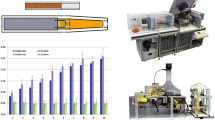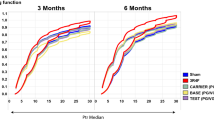Abstract
The comparative acute toxicity of a branded American cigarette and kreteks (Indonesian cigarettes containing approximately 60% tobacco and 40% ground clove buds) was assessed by exposure of groups of ten male and ten female rats to three different but equivalent (in terms of total particulate matter) concentrations of smoke from each type of cigarette. The smoke was delivered “nose only” using an HRC Rodent Smoking Machine (Mark IV) within a single 1-h period, with a total delivery of 30 min smoke and a 15 min air-breathing period between the two smoke exposures. Comparison of the immediate response to smoke exposure was made by monitoring respiration during exposure and by observation of the animals immediately following exposure. At this level, the only differences observed were more severe signs of smoke intoxication in the American smoke exposed animals which, at least in part, was attributed to the higher concentrations of carbon monoxide (CO) to which these animals were exposed; CO concentrations in the American smoke atmospheres were 2–2.5 times higher than the corresponding kretek smoke atmospheres. Comparison of any delayed response was made by observation and measurement of body weight, food and water consumption for a sub-population maintained for 14 days following exposures. This comparison revealed no differences between the groups which could be attributed to the smoke exposures. Comparison of any lung changes induced were made at two intervals, 24h and 14 days following smoke exposures. These intervals were selected to provide information on any damage to the lung attributable to the smoke exposures and any subsequent development or repair. Lung changes were assessed by measurement of lung weights and by histopathological examination. Comparison of lung weights revealed no substantial differences between the groups which could be attributed to the smoke exposures. No qualitative histopathological differences were detected between the different types of cigarette either at 24 h or 14 days after exposure. However, a slight increase in the incidence and severity of focal alveolar haemorrhage was present in the high dose American group at 24 h compared with the high dose kretek group killed at the same time interval.
Similar content being viewed by others
References
Clark GC (1986a) Concerning the article “Toxicity studies on clove cigarette smoke and constituents of clove: determination of the LD50 of eugenol by intratracheal instillation in rats and hamsters” by LaVoie et al. Arch Toxicol 59: 296–297
Clark GC (1986b) Comparison of the response of rats exposed to equivalent concentrations of smoke from American or Kretek cigarettes — comparative acute toxicity. Huntingdon Research Centre (HRC) Report FPA 1/851513
Clark GC (1986c) Comparison of the response of rats exposed to equivalent concentrations of smoke from American or Kretek cigarettes — comparative 14-day toxicity. HRC Report FPA 2/86238
Clark GC (1986d) Eugenol: acute inhalation toxicity in rats — 4 hour exposure. HRC Report FPA 3/86101
Guidotti TL (1985) Possible risks to health associated with clove cigarettes. Chronic Diseases in Canada 6: 3–6
Guidotti TL, Binder S, Stratton JW, Schechter FG, Jenkins RA (1987). Clove cigarettes; development of the fad and evidence for health effects. Current Topics in Pulmonary Pharmacology and Toxicology 2: 1–23
Hammond EC (1980) The long-term benefits of reducing tar and nicotine in cigarettes. In: Gori GB, Bock FG (eds) A safe cigarette? Banbury Report 3, Cold Spring Harbor, NY, pp 13–18
Kunze M, Vutuc C (1980) Threshold of tar exposure; analysis of smoking history of male lung cancer cases and controls. In: Gori GB, Bock FG (eds) A safe cigarette? Banbury Report 3, Cold Spring Harbor Laboratory, Cold Spring Harbor, NY, pp 29–36
Lam R (1980) Transient epithelial loss in rat larynx after acute exposure to tobacco smoke. Toxicol Lett 6: 327–335
Le Bouffant L, Martin JC, Daniel H, Henin JP, Normand C (1980) Action of intensive cigarette smoke inhalations on the rat lung. Role of particulate and gaseous cofactors. J Natl Cancer Inst 64: 273–284
Purser D (1988) Comparison of the response of rats exposed to equivalent concentrations of smoke from American or 100% clove bud cigarettes; comparative 14-day toxicity. HRC Report FPA 4/871678
Ulrich CE, Haddock MP, Alarie Y (1972) Airborne chemical irritants: role of the trigeminal nerve. Arch Environ Health 24: 37–42
Wise MB, Holladay SK, Higgins CE, Jenkins RA, Guerin MR (1986) The chemical characteristics of smoke delivered by clove-containing cigarettes. In: Hoffmann D, Harris C (eds). New aspects of tobacco carcinogenesis. Banbury Report 23, Cold Spring Harbor Laboratory, Cold Spring Harbor, NY, pp 151–162
Author information
Authors and Affiliations
Rights and permissions
About this article
Cite this article
Clark, G.C. Comparison of the inhalation toxicity of kretek (clove cigarette) smoke with that of American cigarette smoke. I. One day exposure. Arch Toxicol 63, 1–6 (1989). https://doi.org/10.1007/BF00334625
Received:
Accepted:
Issue Date:
DOI: https://doi.org/10.1007/BF00334625




